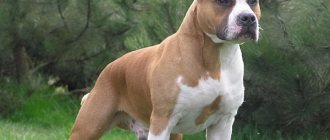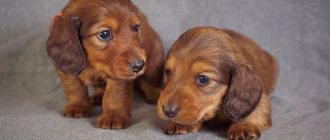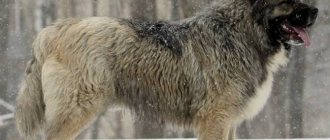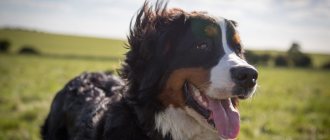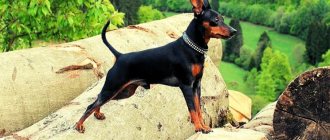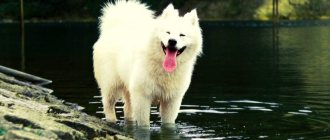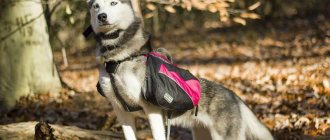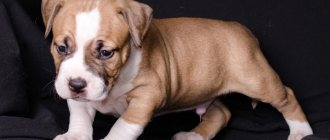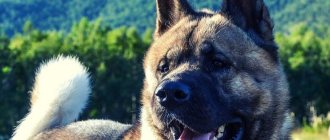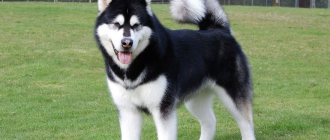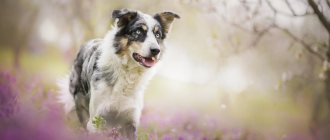Representatives of the breed are distinguished by stubbornness and willfulness. For inexperienced dog owners, these character traits become an obstacle to education and training. The result is disastrous - the pet grows uncontrollable and attacks other animals and people for no reason. Because of such, far from isolated cases, society has developed a stereotype of the bloodthirsty bull terrier. Meanwhile, the Boule is by nature very intelligent, cheerful, and friendly to people. Proper training will make him a wonderful companion and protector for the whole family.
Characteristics of Bull Terriers
It is important to understand the character and behavior of your pet. What to expect from him? Where to show patience? Why not wait? And what requires special attention? The reputation of the Bull Terrier breed, unfortunately, is greatly distorted; it is often presented as fighting, uncontrollable and aggressive.
REFERENCE. As scientists noted when studying dog breeds, 20% of a dog’s character is inherited traits, and 80% depends on upbringing.
The breed is truly serious and should be treated as such. Owners of bull terriers note that these dogs are gentle and kind towards people. They have high intelligence and quickly recognize what their owner wants from them.
Pay close attention to what your pets especially need, this is necessary for them to be confident and happy. They are very jealous and will not tolerate mistreatment, don't even count on it. For example, it is strictly forbidden to tease dogs.
IMPORTANT! Choose games with your dog carefully so that he will evaluate them correctly.
Bull Terriers can be guard dogs, but this is not their strong trait. You can have a warm relationship with children, but it’s better not to leave them without control. An unneutered male dog is more aggressive and can be dominant over neutered dogs. You need to find an approach to this breed; you won’t be able to train it at will, because it has its own unyielding and arrogant character.
Maintenance, proper care
The dog feels best in a private home. When kept in an enclosure, she needs a warm booth, because the breed is not very adapted to Moscow humidity and dampness. Buhl will tolerate a cramped city apartment, provided he is given walks with good physical activity.
The dog doesn't like to be left alone. He lives peacefully with other pets if he has grown up with them since puppyhood. But it’s still better if they don’t exist - the pet won’t want to share your love with anyone. He can constantly sort things out with his relatives.
In general, the breed is endowed with good health, but there are congenital problems with the eyes (entropion), kidneys (polycystic disease), and elbow dislocation.
Care:
- Food - dry food designed for bull terriers, or general, premium food, but according to the age and weight of the dog. The basis of the natural menu is beef, sometimes poultry, fish, to which cereals, vegetables, cottage cheese, and vitamins are added.
Hygiene procedures. The short and smooth coat does not require special care. She doesn't get dirty, so bathing as needed. Dead hairs during shedding are removed with a rubber glove. Regular examination of the ears and eyes will help avoid infections and inflammations. If a dog walks a lot, its nails wear down on its own.- Walking is important for maintaining physical fitness - at least 2 hours a day with a variety of sports exercises in large quantities, interesting activities. If the load is not enough, the bull can quickly gain excess weight (tendency to obesity) and develop bad habits.
The subtleties of raising puppies
There are several ways to influence the training process. One of them: praise and give a treat for correct performance.
Second: when issuing a command, help in its execution. For example, the command “sit!” accompany with pressure on the croup. And, of course, you need to combine these methods.
IMPORTANT! At the training stage, the owner needs to be consistent and not jump from team to team or from one task to another. WHAT'S EVEN MORE IMPORTANT: Don't hurt the puppy!
A few main points.
- Become the head of the bull terrier, otherwise he will dominate, then you will get an uncontrollable dog.
- Turn training into a game, as a stubborn person cannot stand monotony.
- The Bull Terrier is not a service dog; it is not worth demanding exceptional precision in the execution of a command. I sat down, and thank you for that.
- Beating and screaming will damage the puppy’s delicate psyche irrevocably. They are very smart and sensitive. A stern look, deprivation of something tasty or a toy is enough, and the pet will understand everything.
- Don't give up and praise your pet as much as possible.
- If the dog forgot something, repeat it. And follow the principle: from simple to complex.
- Dogs do not have the memory to analyze recent actions: they perceive punishment or praise only for the last execution of a command.
IMPORTANT! In fact, you should not be engaged in training, but in raising your pet.
Breed standard
- In the modern concept, the Bull Terrier is a compact dog with strong, well-developed muscles. In this case, the dog must have an athletic body, its movements are flexible, it moves easily when running.
- The size of representatives of this breed is not limited by the standard, the main thing is that the height and weight are harmonious and correspond to the gender of the animal. Males are slightly larger than females. An adult has a height at the withers of 53 to 56 centimeters. Their minimum weight is eighteen kilograms, and their maximum weight can reach thirty-six kilograms.
- The appearance characteristics of these dogs are slightly different from other representatives of boules. They have a long head with an oval skull and a flat area between the ears, shaped like an egg. They are distinguished by powerful, strong jaws that have a bite similar to a scissor mechanism. Therefore, it is almost impossible to escape from the jaws of such a beast.
- A unique feature of the Bull Terrier breed is the presence of narrow, slanting, deep-set, triangular-shaped eyes. They are located at a considerable distance from the nose. According to the breed standard, dogs' eyes should be a dark shade of brown. Animals with light eye color are not considered purebred and are disqualified from exhibitions.
- The noses of bull terriers have expressive open nostrils, located on the muzzle in a downward direction.
- The ears are positioned straight, vertical, and do not droop. They are planted quite close, have a triangular shape, and are small in size.
- Representatives of this fighting breed have strong, muscular limbs of medium length. The front pair of paws is more developed; they are quite stable. The knees on the hind legs are flexible. The toes are compact and mobile.
- The animal has a short and strong back.
- Bull Terrier tails are not docked; they are set low, short and tapering to the tip.
- The coat of dogs is hard, has little shine, and the hairs themselves are short and straight. During the cold season, the animal develops a soft undercoat.
- There are two color options for the Bull Terrier. White color is classic for this breed, but color variations are also possible. Pigmentation on white fur is allowed. If the animal has a colored coat, the primary color should predominate.
What an adult bull terrier should know and be able to do
The requirements are as follows:
- Definitely, an adult dog must understand who is boss in the house, where his place is, literally and figuratively.
- Respond immediately to a nickname, know everyday commands.
- Be mentally resistant to loud noises, be able to walk on a leash and next to the owner.
- Be calm about the muzzle.
- Do not rush or bark at people or other animals, passing vehicles or children playing.
- Must be able to remain calmly on a leash for long periods of time.
- The breed is capable of mastering sports disciplines. If you set this goal, then at special sites the instructors will explain the plan of action to you.
ADVICE. There is a specialized course UGS - Controlled city dog. Be sure to use it. Beyond this you should not expect anything from a bull terrier. The main thing is to have time to develop these basic disciplines before one and a half years.
Appearance
The Bull Terrier has a strong, muscular build. The dog's head is long, and from the side it looks like an egg. On top it is almost flat, arched from the top of the head to the nose. The nostrils are pronounced and open. The dog has strong teeth with a regular scissor bite.
Animals have a special eye shape, similar to a triangle, with an oblique fit. The color is dark brown.
These dogs have small, thin, erect ears located next to each other.
The body is round in shape with protruding ribs. A dog's chest is located much lower than its stomach.
The weight of one individual is from 18 to 30 kg. Height – 35-45 cm. The exception is miniature dogs, their height at the withers does not exceed 35.5 cm.
Common bull terrier colors: black and white, brown, red, brindle, black.
Tips from dog handlers
- There are programs for monthly training of a bull terrier. Experts advise contacting them to raise your pet step by step and without missing anything important.
- If you are new to raising dogs in general, and have not had any training experience on any breed, then do not start your dog breeding practice with a bull terrier. Of course, later you will still have to learn how to raise this particular breed, but with training experience and advice from a cynologist guru it will be easier.
- Keep in mind in your education that the breed has a hierarchy. As soon as you scold the children in his presence, he will immediately “put” them on the lower level after himself.
- Start serious education at 6 or even 8 months.
IMPORTANT! The Bull Terrier is one breed that can hate training. Your task is to prevent this from happening, so don’t start too early.
- If you feel irritated during the education process, then it is better to stop.
- A golden mean is needed: without training and attention, the dog will be aggressive and uncontrollable, but if you go too far, the effect will be the same.
Be balanced, calm and kind, then your pet will be the same. He will become a devoted companion and good friend.
Similar articles
Brief history of origin
Bull Terriers were bred in the 19th century in England. In those days, fights between dogs, in which bulldogs actively participated, were popular. But the spectators were not satisfied with the entertainment; they wanted more emotions from such events. Thus began the search for more resilient dogs with absolute fighting qualities.
The breed was created by crossing a bulldog and a white English terrier. It combines such qualities as dexterity, strength, a minimum threshold of pain sensitivity, resilience and strength of character. But with all these advantages, the bull terrier is short in stature.
Photo gallery
Before getting yourself such a dog, think about whether you are ready to devote enough time to training it. Indeed, in the case of a bull terrier, lack of education is fraught with serious consequences.
Nutrition
The Bull Terrier needs a high protein content, high-calorie, easily digestible food, vitamins and microelements.
Dogs are fed in two ways: prepared (dry, canned) or natural food.
- For the first weeks, puppies of 2-3 months are fed the same way as the breeder did. Then the diet consists of 50% meat products and offal. Some of the dog's food is given raw, cut into pieces. Your dog's diet should also include:
- fermented milk products (kefir, yogurt, cottage cheese, cheese, sour cream, cream);
- fresh, grated vegetables (pumpkin, carrots, cauliflower, zucchini);
- rye bread and crackers, as well as a variety of cereals;
- eggs (it is not recommended to give your dog more than three times a week).
At this stage, vitamin and mineral complexes are added.
- The diet of an adult bull terrier differs from the diet of a three-month-old puppy only in the amount of food. The meat is cut into pieces, but the vegetables are given whole.
Dogs are prone to obesity, so they should not be fed baked goods made from white flour, sweet fruits, fatty foods and prepared meat delicacies (sausage, smoked sausages). It is also not recommended to give dogs grapes, raisins, chocolate, rabbit and chicken bones, fish and legumes.
Dossier
Height of an adult dog: 26-36 cm. Weight: up to 11 kg. Characteristic color: very varied. Coat length: shorthair. Life expectancy: up to 14 years. Advantages of the breed: cheerful, cheerful, energetic. Difficulties of the breed: stubborn, persistent. Without proper upbringing, he can become a brawler. Average price: $1,000. Classification: small, fighting, security, apartment.
At what age do you start training?
Puppy training must begin from the very first days
the presence of a dog in your home. Because already from infancy, the puppy must learn the rules of behavior in your house, what is allowed and what is forbidden, how to behave with all family members, even the smallest and oldest, what he can play with and what he can’t, where to go. toilet and much more.
And we are talking, first of all, about the proper upbringing of a bull terrier puppy, and you can start training and learning commands when the puppy is completely comfortable in your home. As a rule, one week is enough. By this time, the puppy is already filled with curiosity and is diligently exploring the world around him. If, after this time, the puppy remains fearful and does not make contact well, then it is better to seek help from a dog handler-animal psychologist, because This behavior is not typical for puppies of this breed.
Training at 3 months. Socialization
Three months is an important stage in a bull terrier puppy’s introduction to the outside world. Your first walks should be short and not too tiring for the puppy. You should start with 15 minutes, gradually increasing the walking time to 1 hour.
Correct formation of the nervous system
At this age, the puppy’s nervous system is forming.
. It has been proven that raising puppies in isolation during this important period contributed to the development of pronounced cowardice in them later. It is necessary to show the puppy as much as possible: noisy streets, large crowds of people, etc. Everything that he will have to face in later life.

